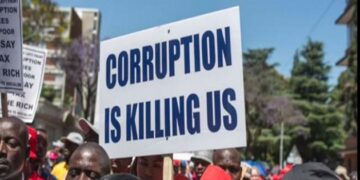Africa, according to the International Rescue Committee, is home to seven of the 10 countries most vulnerable to climate disasters. These countries, however, are among the least contributors to the emission of greenhouse gases, mainly Carbon dioxide, that are produced as a result of the burning of fossil fuels like oil, coal, and gas, as well as deforestation and cement production. They have the lowest average Carbon dioxide (CO2) footprints at about 0.1 tonnes per year, yet they are the most exposed to global warming and climate change disasters such as drought, floods, heatwaves, and tropical cyclones. They include Somalia, Democratic Republic of Congo, Chad, South Sudan, Central African Republic, Nigeria, and Ethiopia. The non-African countries that make the list include Syria, Afghanistan and Yemen.
According to the IRC, “Climate change has had a devastating impact on Somalia, worsening challenges of drought and extreme food insecurity”. In March 2023, flash floods “affected 460,000 people in Somalia, displacing tens of thousands”. The country’s political instability, the IRC noted, “has made it difficult to address its climate crisis and protect vulnerable communities”.
For the DRC, the IRC pointed out that “the frequency of torrential rainfall” has “accelerated over the last ten years” For example, it said: “In May 2023, they caused serious flooding and landslides in South Kivu, wiping out entire villages, affecting more than 15,000 people and tragically claiming over 500 lives”. Persistent conflict (over 100 armed groups fight for control in eastern Congo, often targeting civilians), economic challenges, and disease outbreaks (measles, malaria, and Ebola) have weakened the country’s ability to prepare for climate disasters and disrupted humanitarian support while citizens face floods and rising food insecurity, the IRC noted.
Describing Chad as “the world’s most climate-vulnerable country” on the Notre Dame-Global Adaptation Initiative Index, which examines a country’s exposure, sensitivity, and capacity to adapt to the negative effects of climate change, the IRC said flooding in late 2022 affected more than 1 million people in the country while an economic crisis has led to widespread food insecurity. It mentioned that growing conflict and tensions related to the country’s Transitional Military Council have limited progress in building climate resilience.
With South Sudan, the IRC said the country has “high fragility and low climate readiness”, thus, becoming “increasingly vulnerable to climate disasters”. It recommends “better climate resiliency to protect South Sudanese citizens from climate shocks, like the severe floods that affected over 900,000 people in late 2022”. However, it noted that despite the end of the civil war in 2018, local conflicts remain widespread, putting South Sudan in a poor state as far as fighting climate change disasters is concerned.
Concerning the Central African Republic (CAR), the IRC said “severe flooding threatens the safety and health” of the citizens, “particularly those living in camps for internally displaced people, by contributing to the spread of water-borne illnesses like cholera. Other diseases like malaria, meningitis and monkeypox also strain CAR’s weakened health system”.
In West Africa, it singled out Nigeria, referring to the flooding in late 2022 that affected 2.5 million people and caused “extensive damage to the country’s farmland”. It projected that by mid-2023, an estimated 25 million Nigerians were to face “high levels of food insecurity” as a result of climate disasters.
In Eastern Africa, the IRC said drought is affecting more than 24 million Ethiopians and warned that the number was expected to rise as the country entered its sixth consecutive failed rainy season. Numerous internal conflicts as well as the Russia-Ukraine war, it noted, have hampered and worsened the food insecurity crisis in Ethiopia and other East African Countries. For instance, it said after Russia withdrew from the Black Sea Grain Initiative, a mechanism that allowed Ukraine to resume grain exports to countries like Ethiopia which sources 90% of its wheat from Ukraine and Russia, food prices increased drastically across the region.
Africa’s Global CO2 Emissions Contribution vis-à-vis others’
In 2021, the world produced 37.12 billion tonnes of CO2. Oxfam says the richest 10% of people make more than half of this pollution.
Africa doesn’t produce as much CO2 as other continents. China makes the most with 11.47 billion tonnes, followed by the United States (5 billion tonnes), India (2.7 billion tonnes), Russia (1.75 billion tonnes), and Japan (1.07 billion tonnes). Africa makes only 1.45 billion tonnes, even though it has 17% of the world’s people.
Each person in Africa makes just 1 tonne of CO2 each year. South America makes 2.5 tonnes per person, Asia makes 4.6 tonnes, Europe makes 7.1 tonnes, Oceania makes 10 tonnes, and North America makes 10.3 tonnes. That means an average person in the US or Australia makes as much CO2 in a month as someone in Africa does in a year.
Three countries in Africa make more than 60% of the continent’s CO2: South Africa makes 435.9 million tonnes, Egypt makes 249.6 million tonnes, and Algeria makes 176.2 million tonnes. South Africa mostly uses coal for its CO2. Libya, an oil-producing country, makes the most CO2 per person in Africa.
Finding solutions
On 28 November 2023, Dr Akinwumi A. Adesina, President of the African Development Bank Group, delivered the keynote address at the 40th-anniversary celebration of The Guardian newspaper in Lagos, Nigeria, via which, among other things, he addressed the issue of climate change and its impact on Africa’s development.
He said climate change is “devastating many parts of Africa”, noting: “Drought and desertification across the Sahel, and in the Horn of Africa, and cyclones in Mozambique, Zimbabwe, Malawi, and Madagascar, have had devastating effects”. Adesina said Africa, which accounts for just 3% of all historical emissions, “now bears the most severe effects of climate change. Nine of the 10 countries most vulnerable to climate change in the world are in Africa”. Africa’s wealth, he fumed, “is being lost at a frenetic pace to climate change, with $7–15 billion in annual losses. This is estimated to rise to $50 billion a year by 2030. While the developed world grew their economies, created massive wealth, jobs, and raised living standards from the Industrial Revolution, they did so at the expense of the global common – the environment – by using 85% of the global carbon budget. Africa’s carbon emissions are dwarfed by the emissions of other continents. To put it in perspective, an average American or Australian emits as much CO2 in a month as an individual in Africa does in one year. However, global finance for climate is short-changing Africa, providing only $29 billion of the $653 billion in climate finance globally”.
To give zest to Africa’s voice and needs, the AfDB President said the bank launched the $25 billion African Adaptation Acceleration Programme to deliver greater financing for climate adaptation in Africa. Building off its successful programme that ensures countries against extreme weather patterns covering 15 countries, the AfDB, he added, has launched a $1 billion Africa Climate Risk Insurance Facility for Adaptation (ACRIFA) to scale up insurance of countries against climate risks.
Adesina believes Africa can take its rightful place in the world economy if she goes green to feed her power needs. “Africa has the largest renewable energy potential in the world, including solar, hydro, wind and geothermal. The problem is that while it has 60% of global solar power potential, it uses only 1%. Yet, it has 600 million people without electricity”. In addition, Adesina said, “close to 1 billion Africans do not have access to clean cooking energy, and as a result, over 300,000 women die annually from the use of polluting cooking fuels such as biomass and kerosene, while another 300,000 of their children also die annually because of indoor pollution”.
According to the International Renewable Energy Agency, however, Africa “has been overlooked in the global energy transition”, a situation Adesina describes as “unfortunate”. “The facts bear this out: Africa received just $60 billion (or 2%) of the $3 trillion of global investments in renewable energy in the past two decades, and accounts for only 3% of all jobs created in renewable energy. Clearly, there is underinvestment globally in supporting Africa to unlock the full potential of its vast renewable energy sources. This is unfair, unjust, and unacceptable”, Adesina decried.
The bank’s New Deal on Energy for Africa, launched in 2016, Adesina mentioned, is one to accelerate the access of Africans to electricity. “Since the African Development Bank launched its New Deal on Energy in 2016, electricity access rate in Africa has expanded from 32% to 57%. Despite setbacks due to COVID-19, some countries such as Ethiopia, Tanzania, and Kenya have achieved remarkable progress and accounted for more than 50% of those gaining access to electricity in Africa between 2015 and 2019. The Bank’s support to Morocco helped it achieve 98% of electricity access across its rural areas”.
Investing in renewables
The African Development Bank, he added, “is at the fore of unlocking Africa’s renewable energy potential. We supported the building of the largest concentrated solar power station in the world, in Morocco; supported the building of the largest wind power station in Africa, in Kenya. We have invested $210 million in the development of the transmission lines for Nigeria and plan to support a 1,000 MW solar power plant in Jigawa, as well as Nigeria’s first public-private partnership power transmission lines in Lagos State. We are implementing a $20 billion programme, Desert to Power, to develop 10,000 MW of solar across 11 countries of the Sahel zone, which will provide electricity for 250 million people. When completed this will become the world’s largest solar zone. Africa must fully unlock the massive potential of the Grand Inga dam in the Democratic Republic of the Congo with its 44,000 MW hydropower potential. Despite huge potential, it remains untapped. On a visit to this amazing site, I asked the community where Inga is located what the name ‘Inga’ means. I was told it means ‘Yes’. Asked to sign the visitor’s book, I wrote, ‘The African Development Bank says, ‘Yes’. With all its potential, Africa cannot justify not having electricity. Yes! 100% electricity access is achievable”. The world has never treated Africa fairly and that won’t change for decades or centuries to come. This means whatever unfairness the continent is suffering right now, in terms of the climate change question, will persist. It is, therefore, incumbent on Africa to harness the power of the wind, water and sun for her peoples. Instead of allowing the rain to cause destructive floods, let’s harness that water power in dams for electricity and irrigation. Instead of allowing the hot sun to bake Africa dry, let’s harness its heat for power production through solar farms. Instead of allowing strong winds to topple our trees and buildings, let’s harness their power for electricity with wind turbines. The world will not do it for us. We are on our own. And we must find our own solutions to our power problems.






























